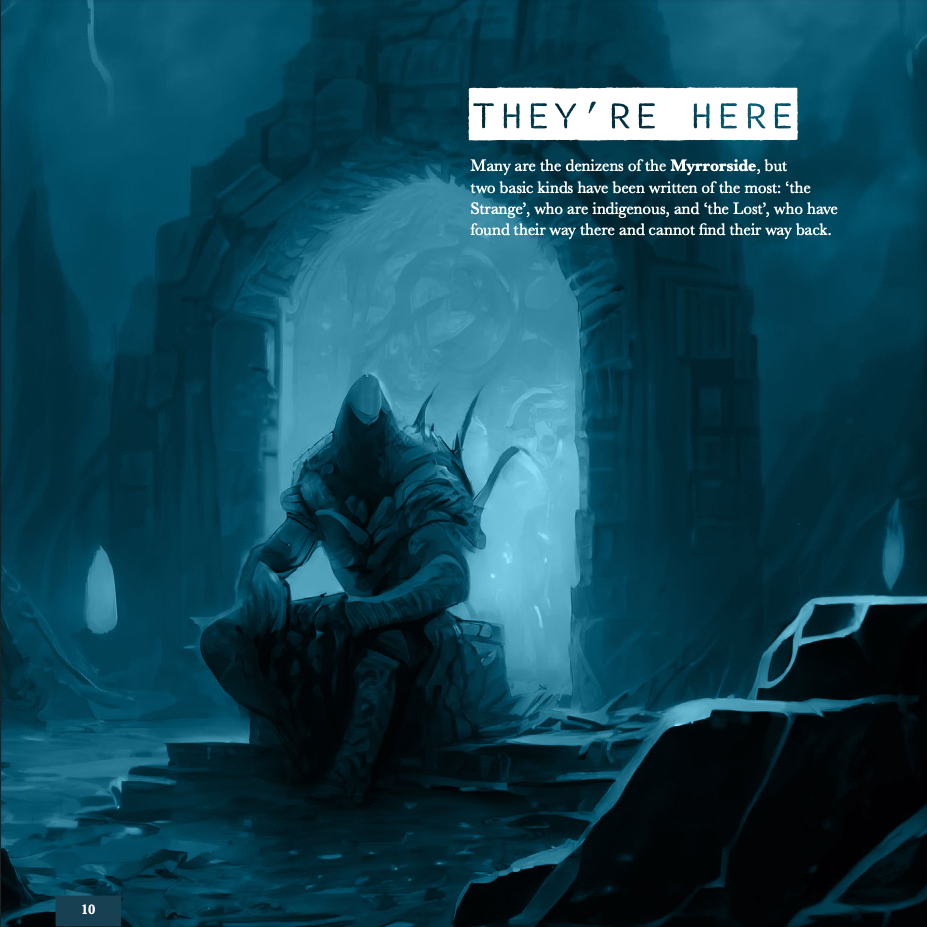Podcast: Play in new window | Download (Duration: 34:32 — 29.3MB)
Subscribe: Apple Podcasts | Google Podcasts | Stitcher | TuneIn | RSS | More
Podcast (httptherpgacademy-comfeedlive): Play in new window | Download (Duration: 34:32 — 29.3MB)
Subscribe: Google Podcasts | RSS
Audio Player
Hello and welcome to The RPG Academy’s The Review series. Today The Caleb G (@TheCalebG) takes a look at Myrrorside by Angus McNicholl / Parallel Publishing.
Howdy cats and kittens! It’s TheCalebG aka Professor Crunch aka the founder of Point Five Past.Today I’m here to review Myrrorside, a Parallel Publishing game created by Angus McNicholl. At the time of writing this article, the book is available on Drive Thru RPG in PDF, softcover, and hardcover versions. The publisher was kind enough to send a copy of the book for the purpose of this review.
Quick Overview
Myrrorside is a horror game in a modern setting where magic and scary things come from an alternate reality hidden behind the real world. Its mechanics are easy to understand and have a moderate level of complexity. There’s a nice balance between narrative flexibility and mechanical guidelines. The game works best when it’s used to tell stories in episodic fashion, similar to horror TV shows or mini-series.
Book
At right around 100 pages, the book is easy to read and use as a resource during gameplay. Myrrorside is a focused world simulator, providing a vibrant setting for players to use as they wish. The first 14 pages are focused on that setting and there is not a specific story or named characters to follow.
It’s worth noting that there is only half a page dedicated to safety rules at the game table. There is an abundance of information on this topic in the gaming zeitgeist, so what’s presented here is clearly a quick summary. Some may find this refreshing as it does not repeat information needlessly. Others may find it concerning and not considerate of players who may not have a wealth of experience at the table.
The remainder of the book provides gameplay instruction, mixing in small pieces of setting lore occasionally for flavor. Overall, the book’s layout is average. It’s easy to read and is well-organized. However there is a lot of empty space that could be used for examples, supplemental information, flavor text, or art.
The interior art is all in shadowy shades of teal, presenting a moody atmosphere that carries a persistent sense of dread. Like the green tones in The Matrix, this teal shading informs readers that something is different in this world and that the world is consistently dangerous.
Setting
The scary, horror-filled world of Myrrorside is presented as the underlying foundation of reality. The real modern world is built upon this terrible structure, like an operating system. The surface levels of the Myrrorside are just like reality, only slightly different. In some places there is an overlap between worlds and it’s possible for people and other beings to slip between them. Going further and deeper into the Myrrorside reveals the sprawling nightmarish world where human understanding breaks down and everything is trying to kill everything else.
Modern technology breaks down in the Myrrorside. Old-fashioned analog tech will still function, but digitally-powered devices like smartphones either stop working entirely or start glitching in strange ways. Likewise, the magic of the Myrrorside works only briefly in the real world, dissipating quickly. This keeps most of the game action set in the Myrrorside’s reality. Magical effects and terrible monsters can bleed over into the real world, but their impact is fleeting.
The Myrrorside is populated by native creatures, called the Strange, and by humans that have been trapped in and warped by this alternate reality, called the Lost. There are many variations within these categories, but all are deadly to humans.
Core Mechanics
This game uses the 2dx Operating System. PCs have 4 Attributes and 24 Skills, all of which are rated by dice size from d2 to d12. After narrating their action, players make an Action Test by rolling the applicable Attribute and Skill dice, picking the highest result, then adding positive or negative modifiers. Opposed Tests happen when PCs and NPCs are in conflict. The magnitude of success or failure after comparing results is used as a guide to inform the role play of how events happen. An unopposed Action Test happens when the PC simply acts against the environment, similar to a Skill Check in a standard d20 system. A negative modifier to reflect the difficulty of the task is applied to the Test. A positive result is a success, a negative result is a failure, and a result of zero is a success at a cost.
Beyond situational modifiers to the Test, there is also a system of Advantage and Disadvantage. Unlike other systems using the same words, Myrrorside does not treat this a reroll. Instead, it adds an extra Attribute dice to the roll for every Advantage and Disadvantage gained in the Test. Then players remove dice until they have only two remaining. Advantages remove the lowest results while Disadvantages remove the highest results. Advantages and Disadvantages are cumulative and do not cancel each other out.
As this is a horror game, Myrrorside includes two mechanics that attempt to reinforce the dramatic tension of storytelling. The first is called Pulse or Tension. It can be raised through horror elements being played out and lowered by humanity-reaffirming moments. Higher levels of Tension inflict a variety of penalties that attempt to replicate emotional states of fear. The second of these mechanics is called Collateral. Players can take a Collateral token to convert any failed Action Test to a success as if the dice results were zero. Beyond the success at a cost that a result of zero brings to the story, Collateral has a variety of additional negative impacts on PCs.
Character Creation and Gameplay
Building characters is incredibly easy. The book provides the starting dice size for Attributes and Skills and gives simple instructions for improving dice according to where players want their characters to be focused. Players have the options of taking Quirks and Burdens, which provide mechanical support for roleplaying flavor details. That’s it. There are no classes or special abilities. This is a game about playing regular people dealing with supernatural horror.
Gameplay follows a standard TTRPG flow, with players dealing with the plot as it unfolds. There are no special mechanics included in the book that deal with plot pacing and management, such as filling clocks or moving through a countdown.
Using magic is possible in the game, but it is not easily done. Human characters must use complex rituals to harness magical powers. Each ritual presented in the book includes a casting time and component list. Mechanically, rituals are resolved with Action Tests, which might be opposed or unopposed, depending on the nature of the spell and the situation. On the other hand, creatures native to the Myrrorside can use magic much more easily and frequently.
The last 30ish pages of the book give advice and instruction to game runners. This includes guidance on using thematic tropes and structuring an episodic plot. There is a short bestiary. Also presented is a method of playing the game without a game runner, called Collaborative Meta-Gaming. This gives instructions on how players can create a scene structure, take turns leading scenes, and vote on how events progress with a resource called Influence.
Opinion
I think that Myrrorside has a lot of fun ideas and it delivers a great horror vibe, but the overall presentation needs a little polish.
I like the setting. The concept of our world being the falsehood built on top of a horrible reality is very fun for episodic storytelling. Lore presented in the book is vivid enough to give players a strong understanding of the game’s intended vibe but also open enough to give players and game runners plenty of room to add their own ideas. And the overall idea of regular humans struggling against insurmountable and incomprehensible terror is a fundamental aspect of the horror genre.
Another great feature is the mechanics. They’re easy to learn, excellent for newer players, and they support the horror vibe. The focus on human skill and the difficulty of using any supernatural resources informs players that their characters are up against a difficult struggle with little to no help.
That being said, the book is a little unclear at times. There are a few terms that are not as clear as they could be. For example, humans that visit the Myrrorside are called “firewalkers”, but this is really only picked up through context. Some creatures and world details are mentioned once and never given any further explanation. None of this really has a negative impact on the game, but it’s frustrating.
There are also a few mechanical details that are a little rough around the edges. For example, there is guidance for how to increase and decrease the Pulse or Tension (and the fact that both terms are used simultaneously is another point of confusion) and there is a list of what happens mechanically at the various levels of Tension. But there is no actual numerical value assigned to those levels. Similarly for Collateral, while the consequences of gaining it are provided, there are no clear instructions for how those consequences are applied to characters. While it’s not hard for a game runner to come up with a solution, it’s something I feel should’ve been included, especially since these features are so fundamental to supporting the horror tones of the game.
Likewise, the bestiary feels lacking. The lore tells players the entire Myrrorside is full of deadly creatures, but the book only gives a few examples and no instructions for how to create more. There are references to unique creatures that would be a natural fit for recurring villains in the episodic game, but very little support for them. Again, it wouldn’t be hard to figure it out, but why is it not part of the book?
In general, I like Myrrorside. I love the opportunity to tell a story about humans in an impossible struggle, especially when the mechanics of the game support that tone. The setting is a nice combination of horror tropes and gives players lots of room for creativity. And the game is very accessible to new TTRPG players. But the game feels incomplete. A lot of the details and information are vague. While the unknown is a core aspect of the horror genre, that should apply to the characters, not the players. I think that Myrrorside has potential but falls short of other similar games in the episodic horror genre.
Rating: C-
Please consider contributing to my Patreon, making a modest donation via Paypal or even support your show at no extra cost via your purchases on DriveThru RPG.
Email: TheRpgAcademy@gmail
Twitter / Facebook / Website
Our Intro and Outtro music is Fly a Kite by Spectacular Sound Productions used via Creative Commons Attribution License
Playing Roleplaying games can be an amazingly fun time and also a benefit to your well being. If you or someone you know is struggling with your mental or emotional well being, please reach out to someone who can help:
National Suicide Prevention Lifeline: 1-800-273-8255
Crisis Text Line: Text HOME to 741741













1 pings